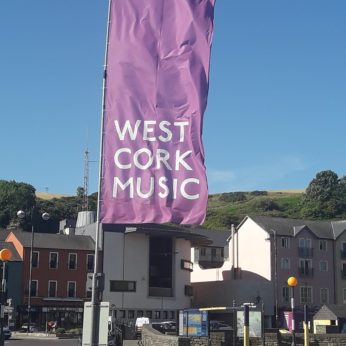Composer: Maurice Ravel (b. 1875 - d. 1937)
Performance date: 02/07/2018
Venue: Bantry Library
Composition Year: 1920-22
Duration: 00:24:05
Recording Engineer: Tom Norton, RTÉ
Instrumentation: vn, vc, pf
Instrumentation Category:Duo
Artists:
Ella van Poucke -
[cello]
Mairead Hickey -
[violin]

29. MAIN EVENING CONCERT – BANTRY HOUSE 20.00
Paule Cotter Memorial Concert
Mairéad Hickey [violin], Ella van Poucke [cello]
Maurice Ravel [1875-1937]
Sonata for violin and cello [1920-22]
Allegro
Très vif
Lent
Vif, avec entrain
I think this sonata marks a turning-point in my career. The music is stripped down to the bone. The allure of harmony is rejected and increasingly there is a return to emphasis on melody.
The aftermath of war found Ravel suffering from crippling sorrow at the death of his mother as well as a deadly combination of dysentery and tuberculosis. This demanded extended periods of treatment and convalescence so by the end of 1920 he had only completed two works Le Tombeau de Couperin and La Valse. Since the death of Debussy, he had been considered to be France’s leading composer and in 1920 was duly offered the Légion d’Honneur, which he absolutely refused to accept – a colleague describes his continually repeated, Baudelairean horror of decorations.
Nonetheless in the spirit of France’s postwar musical revival, the newly formed La Revue Musicale commissioned ten contemporary composers to contribute to an edition entitled Le Tombeau de Debussy. As well as Ravel, the invited composers were Dukas, Roussel, Satie, Schmitt, Bartók, Falla, Goossens, Malpiero and Stravinsky. Ravel’s contribution was the first movement of the Duo Sonata.
The complete work took him eighteen months to compose, which gives some idea of the difficulties he was having. This devil of a duo is giving me a lot of trouble – he wrote to one friend in 1921. Then just when he thought he had it finished, he realised that the scherzo was too long and rewrote it from the beginning. It looks nothing much, this machine for two instruments: there is almost a year and a half’s hard labour in it. In that time Milhaud would have been able to produce four symphonies, five quartets and several settings of Paul Claudel.
The paradox at the heart of this duo is how to get the two instruments to collaborate without actually merging their harmonic identities. Even in the first movement when violin and cello seem to work most graciously together, there is a tension between them that prevents either instrument overwhelming the other. In the rewritten scherzo the two instruments are awarded different key signatures thus ensuring their harmonic divergence. It is a crackling movement, bursting with colour and energy, driven forward by the power of the pizzicatos. The strange little off-centre Trio leads straight into a fortissimo reprise.
The slow movement begins as thoughtful conversation before rising to frenzied debate and then returning to the original melodious ideas. The last movement is based on a fanfare motif that is broken into by a lyrical episode that recalls the opening movement. The fanfare is then ever more fantastically developed until it sounds as though a full quartet is playing, leading to stunning finish.
Francis Humphrys
Copyright © 2025 West Cork Music. All rights reserved.
Designed and developed by Matrix Internet